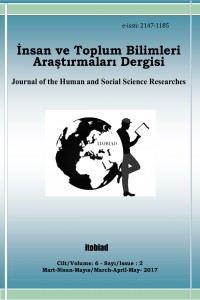Kardiyopulmoner Resüstasyon (Temel Yaşam Desteği) Eğitimi Alan Sağlık Yüksekokulu Öğrencilerinin Bilgi ve Beceri Düzeyleri: Altı Aylık İzlem Sonuçları
Abstract
Bu araştırma
kardiyopulmoner resüstasyon (Temel Yaşam Desteği- TYD) öğrenme programının
etkisini, programın başarısını, uygulanabilirliğini değerlendirmek araştırmak
isteğiyle planlandı. Çanakkale Onsekiz Mart
Üniversitesi hemşirelik, ebelik, acil yardım ve afet bölümüne bu program
verildi. Verilen eğitimin altı ay sonrasında yüksek başarı puanı ve pozitif
geri bildirimler alındı. Öğrencilerin uygulamalrı da başarılı bulundu. Sağlık
öğrencilerinin öğrenmesi için kullanılan bu yöntem, izleme- uygulama tekniğinw
temellendirildi. Bu yöntem, edinilen bilginin erken ve geç dönemde akılda
tutulmasında etkili oldu.
References
- 1. Vaizoğlu S, Evci E, Kapısız D, Özcan E, Soylu G, Ünal B, Ünlü N, Zu'by B, Güler Ç. İlköğretim öğrencilerinin temel ilkyardım bilgi düzeyinin değerlendirilmesinde soru tekniğinin etkisi,2003; Sted, 12,6,227-230.
- 2. Bradley P, Bligh J. One year’s experience with a clinical skills resource centre. Med Educ 1999; 33:114-120.
- 3. Şener S, Ersoy G, Özsaraç M, Aksay E, Koyuncu N. The current status and factors affecting the level of knowledge regarding basic life support measured in resident physicians. DEÜ Tıp Fakultesi Dergisi. 2006; 20, 2,95 – 101.
- 4. Brião Rda C, de Souza EN, de Castro RA, Rabelo ER.Cohort study to evaluate nursing team performance in a theoretical test after training in cardiopulmonary arrest. Rev Latino-am Enfermagem 2009; 17(1):40-45.
- 5. Madden C. Undergraduate nursing students acquisition and retention of CPR knowledge and skills. Nurs Educ Today 2006; 26:218-27.
- 6. Monsieurs KG, De Regge M, Vogels C, Calle PA. Improved basic life support performance by ward nurses using the CAREvent Public Access Resuscitator (PAR) in a simulated setting.Resuscitation. 2005;67(1):45-50.
- 7. Hamilton R.Nurses' knowledge and skill retention following cardiopulmonary resuscitation training: a review of the literature.J Adv Nurs. 2005;51(3):288-97.
- 8. Preusch MR, Bea F, Roggenbach J, Katus HA, Jünger J, Nikendei C. Resuscitation Guidelines 2005: does experienced nursing staff need training and how effective is it?Am J Emerg Med. 2010;28(4):477-84.
- 9. Çelik GO, Kıyan S, Tokem Y, Yıldırım Y, Dölek M, Akbinar C, Turaba F. İzmir'de çalışan acil servis hemşirelerinin eğitim gereksinimlerinin incelenmesi.Turk J Emerg Med.2009; 9(2):59-64.
- 10. Ersoy G, Soysal S, Ünalan H, Yenal S, Baruş N Ü, Tırpan K, Türkmen S. Paramedik -Öğrencilerinin CPR (Kardiyopulmoner Resüsitasyon) Bilgi Düzeylerinin ve Bunu Etkileyen Faktörlerin İncelenmesi. Turk J Emerg Med. 2003; 3(1).
- 11. 2005 European Resuscitation Council (ERC) CPR Rehberi: https://www.erc.edu/index.php/guidelines_download_2005/en/ 12. 2010 American Heart Association (AHA) CPR Rehberi: http://www.heart.org/HEARTORG/CPRAndECC/CPR_UCM_001118_SubHomePage.jsp?gclid=CLDDoKfnm6gCFci-zAodTwqGHQ
- 13. George JH, Doto FX. A simple five step method for teaching clinical skills. Fam Med 2001; 33(8): 577-578.
- 14. Gass D, Curry L. Physicians’ and nurses’ retention of knowledge and skill after training in cardiopulmonary resuscitation. Can Med Assoc J. 1983;128:550-551.
Cardiopulmonary Resuscitation Education and Knowledge and Skill Levels of Students in Health School: Results of Six Months
Abstract
This
study was planned in order to investigate the effects of
the cardiopulmonary resuscitation training program on student motivation
and to evaluate the practicability and the success of the cardiopulmonary
resuscitation training program which was given nursing, midwifery and emergency aid and disaster students of the Çanakkale Onsekiz
Mart University. The post-tests (6 months later) gave us high success
ratios and positive feedbacks. The students stated that they had found the
practical training very useful .The method used by health students to learn was
based on the watch-and-practice technique. This method was effective in
achieving both immediate and late retention of acquired knowledge.
References
- 1. Vaizoğlu S, Evci E, Kapısız D, Özcan E, Soylu G, Ünal B, Ünlü N, Zu'by B, Güler Ç. İlköğretim öğrencilerinin temel ilkyardım bilgi düzeyinin değerlendirilmesinde soru tekniğinin etkisi,2003; Sted, 12,6,227-230.
- 2. Bradley P, Bligh J. One year’s experience with a clinical skills resource centre. Med Educ 1999; 33:114-120.
- 3. Şener S, Ersoy G, Özsaraç M, Aksay E, Koyuncu N. The current status and factors affecting the level of knowledge regarding basic life support measured in resident physicians. DEÜ Tıp Fakultesi Dergisi. 2006; 20, 2,95 – 101.
- 4. Brião Rda C, de Souza EN, de Castro RA, Rabelo ER.Cohort study to evaluate nursing team performance in a theoretical test after training in cardiopulmonary arrest. Rev Latino-am Enfermagem 2009; 17(1):40-45.
- 5. Madden C. Undergraduate nursing students acquisition and retention of CPR knowledge and skills. Nurs Educ Today 2006; 26:218-27.
- 6. Monsieurs KG, De Regge M, Vogels C, Calle PA. Improved basic life support performance by ward nurses using the CAREvent Public Access Resuscitator (PAR) in a simulated setting.Resuscitation. 2005;67(1):45-50.
- 7. Hamilton R.Nurses' knowledge and skill retention following cardiopulmonary resuscitation training: a review of the literature.J Adv Nurs. 2005;51(3):288-97.
- 8. Preusch MR, Bea F, Roggenbach J, Katus HA, Jünger J, Nikendei C. Resuscitation Guidelines 2005: does experienced nursing staff need training and how effective is it?Am J Emerg Med. 2010;28(4):477-84.
- 9. Çelik GO, Kıyan S, Tokem Y, Yıldırım Y, Dölek M, Akbinar C, Turaba F. İzmir'de çalışan acil servis hemşirelerinin eğitim gereksinimlerinin incelenmesi.Turk J Emerg Med.2009; 9(2):59-64.
- 10. Ersoy G, Soysal S, Ünalan H, Yenal S, Baruş N Ü, Tırpan K, Türkmen S. Paramedik -Öğrencilerinin CPR (Kardiyopulmoner Resüsitasyon) Bilgi Düzeylerinin ve Bunu Etkileyen Faktörlerin İncelenmesi. Turk J Emerg Med. 2003; 3(1).
- 11. 2005 European Resuscitation Council (ERC) CPR Rehberi: https://www.erc.edu/index.php/guidelines_download_2005/en/ 12. 2010 American Heart Association (AHA) CPR Rehberi: http://www.heart.org/HEARTORG/CPRAndECC/CPR_UCM_001118_SubHomePage.jsp?gclid=CLDDoKfnm6gCFci-zAodTwqGHQ
- 13. George JH, Doto FX. A simple five step method for teaching clinical skills. Fam Med 2001; 33(8): 577-578.
- 14. Gass D, Curry L. Physicians’ and nurses’ retention of knowledge and skill after training in cardiopulmonary resuscitation. Can Med Assoc J. 1983;128:550-551.
Details
| Journal Section | Articles |
|---|---|
| Authors | |
| Publication Date | September 12, 2017 |
| Published in Issue | Year 2017 Volume: 6 Issue: 3 |


